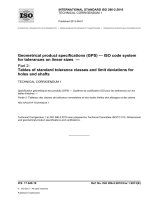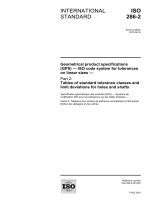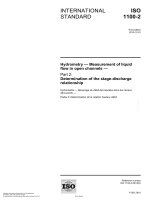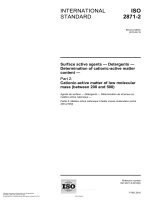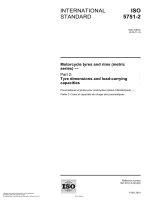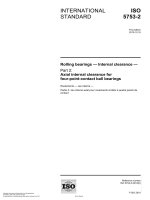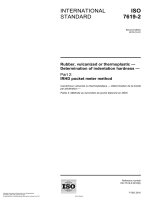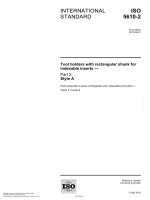Tiêu chuẩn iso 24534 2 2010
Bạn đang xem bản rút gọn của tài liệu. Xem và tải ngay bản đầy đủ của tài liệu tại đây (292.88 KB, 24 trang )
INTERNATIONAL
STANDARD
ISO
24534-2
First edition
2010-07-15
Automatic vehicle and equipment
identification — Electronic registration
identification (ERI) for vehicles —
Identification automatique des véhicules et des équipements —
Identification d'enregistrement électronique (ERI) pour les véhicules —
Partie 2: Exigences de fonctionnement
Reference number
ISO 24534-2:2010(E)
Copyright International Organization for Standardization
Provided by IHS under license with ISO
No reproduction or networking permitted without license from IHS
© ISO 2010
Not for Resale
--`,,```,,,,````-`-`,,`,,`,`,,`---
Part 2:
Operational requirements
ISO 24534-2:2010(E)
PDF disclaimer
This PDF file may contain embedded typefaces. In accordance with Adobe's licensing policy, this file may be printed or viewed but
shall not be edited unless the typefaces which are embedded are licensed to and installed on the computer performing the editing. In
downloading this file, parties accept therein the responsibility of not infringing Adobe's licensing policy. The ISO Central Secretariat
accepts no liability in this area.
Adobe is a trademark of Adobe Systems Incorporated.
Details of the software products used to create this PDF file can be found in the General Info relative to the file; the PDF-creation
parameters were optimized for printing. Every care has been taken to ensure that the file is suitable for use by ISO member bodies. In
the unlikely event that a problem relating to it is found, please inform the Central Secretariat at the address given below.
--`,,```,,,,````-`-`,,`,,`,`,,`---
COPYRIGHT PROTECTED DOCUMENT
© ISO 2010
All rights reserved. Unless otherwise specified, no part of this publication may be reproduced or utilized in any form or by any means,
electronic or mechanical, including photocopying and microfilm, without permission in writing from either ISO at the address below or
ISO's member body in the country of the requester.
ISO copyright office
Case postale 56 • CH-1211 Geneva 20
Tel. + 41 22 749 01 11
Fax + 41 22 749 09 47
Web www.iso.org
Published in Switzerland
ii
Copyright International Organization for Standardization
Provided by IHS under license with ISO
No reproduction or networking permitted without license from IHS
© ISO 2010 – All rights reserved
Not for Resale
ISO 24534-2:2010(E)
Contents
Page
Foreword ............................................................................................................................................................iv
Introduction.........................................................................................................................................................v
Scope ......................................................................................................................................................1
2
Normative references............................................................................................................................1
3
Terms and definitions ...........................................................................................................................2
4
Abbreviated terms .................................................................................................................................4
5
5.1
5.2
5.3
5.4
5.5
5.6
5.7
5.8
5.9
5.10
System requirements ............................................................................................................................5
ERI system context ...............................................................................................................................5
ERT..........................................................................................................................................................5
Operational parameters ........................................................................................................................5
ERT memory allocation.........................................................................................................................6
Security of ERI data...............................................................................................................................6
ERT location...........................................................................................................................................6
Onboard ERI equipment safety............................................................................................................6
Environmental requirements................................................................................................................7
ERT security...........................................................................................................................................7
ERT life cycle .........................................................................................................................................7
6
6.1
6.2
6.3
6.4
6.5
System classification requirements ....................................................................................................8
General ...................................................................................................................................................8
ERT lifetime classification ....................................................................................................................8
ERT power sources ...............................................................................................................................8
ERT read classification .........................................................................................................................9
Onboard ERI equipment categories ....................................................................................................9
7
ERI system organizational framework ..............................................................................................10
--`,,```,,,,````-`-`,,`,,`,`,,`---
1
Annex A (informative) Example user requirements and operational scenarios.........................................11
Annex B (informative) Typical operational usage of onboard ERI equipment ...........................................15
Annex C (informative) Example of ERI system stakeholders.......................................................................16
Bibliography......................................................................................................................................................17
iii
© ISO 2010 – All rights reserved
Copyright International Organization for Standardization
Provided by IHS under license with ISO
No reproduction or networking permitted without license from IHS
Not for Resale
ISO 24534-2:2010(E)
Foreword
ISO (the International Organization for Standardization) is a worldwide federation of national standards bodies
(ISO member bodies). The work of preparing International Standards is normally carried out through ISO
technical committees. Each member body interested in a subject for which a technical committee has been
established has the right to be represented on that committee. International organizations, governmental and
non-governmental, in liaison with ISO, also take part in the work. ISO collaborates closely with the
International Electrotechnical Commission (IEC) on all matters of electrotechnical standardization.
International Standards are drafted in accordance with the rules given in the ISO/IEC Directives, Part 2.
The main task of technical committees is to prepare International Standards. Draft International Standards
adopted by the technical committees are circulated to the member bodies for voting. Publication as an
International Standard requires approval by at least 75 % of the member bodies casting a vote.
Attention is drawn to the possibility that some of the elements of this document may be the subject of patent
rights. ISO shall not be held responsible for identifying any or all such patent rights.
ISO 24534-2 was prepared by the European Committee for Standardization (CEN) Technical Committee
CEN/TC 278, Road transport and traffic telematics, in collaboration with Technical Committee ISO/TC 204,
Intelligent transport systems, in accordance with the Agreement on technical cooperation between ISO and
CEN (Vienna Agreement).
This first edition of ISO 24534-2 cancels and replaces ISO/TS 24534-2:2007, which has been technically
revised.
ISO 24534 consists of the following parts, under the general title Automatic vehicle and equipment
identification — Electronic registration identification (ERI) for vehicles:
Part 1: Architecture
⎯
Part 2: Operational requirements
⎯
Part 3: Vehicle data
⎯
Part 4: Secure communications using asymmetrical techniques
⎯
Part 5: Secure communications using symmetrical techniques
--`,,```,,,,````-`-`,,`,,`,`,,`---
⎯
iv
Copyright International Organization for Standardization
Provided by IHS under license with ISO
No reproduction or networking permitted without license from IHS
© ISO 2010 – All rights reserved
Not for Resale
ISO 24534-2:2010(E)
Introduction
A quickly emerging need has been identified with administrations to improve the unique identification of
vehicles for a variety of services. Situations are already occurring where manufacturers intend to fit lifetime
tags to vehicles. Various governments are considering the needs and benefits of electronic registration
identification (ERI) as a legal proof of vehicle identity with potential mandatory uses. There is commercial and
economic justification in respect of both tags and infrastructure that a standard enables an interoperable
solution.
ERI is a means of uniquely identifying road vehicles. The application of ERI will offer significant benefits over
existing techniques for vehicle identification. It will be a suitable tool for the future management and
administration of traffic and transport, including applications in free-flow, multi-lane traffic conditions with the
capability to support mobile transactions. ERI addresses the need of authorities and other road users for a
trusted electronic identification, including roaming vehicles.
--`,,```,,,,````-`-`,,`,,`,`,,`---
The unique vehicle identifier is held in a secure environment within an electronic registration tag (ERT) fitted to
a vehicle. The identifier used to identify a vehicle is called the vehicle identifier or vehicleId. The preferred
vehicle identifier is the VIN, assigned to the vehicle by its manufacturer in accordance with ISO 3779, or a
variant of this vehicle identifier.
The ERT may contain vehicle data in addition to the unique identifier, as required by authorities or their agents
for ERI applications (e.g. vehicle registration details). An ERT is the core component for simple to complex
applications of ERI, ranging from a simple read-only device, with more complex applications requiring one or
more communications systems.
The ERT may be accessed by an electronic registration reader (ERR), either to read, or read/write data, from
or to an ERT.
Optionally, the ERT may communicate with other onboard vehicle equipment. The potential range of ERI
applications, simple to complex, will require interoperability to exist between an ERT and an ERR by
application.
This part of ISO 24534 illustrates the ERI system concept and the fully featured ERI function enabling simple
to complex applications of ERI.
Whilst it is desirable to determine a single set of requirements for operation in all environments and under all
operating conditions, this could impose unacceptable costs for an ERI application. This part of ISO 24534
provides classification categories of operational parameters for different aspects of a system specification,
enabling appropriate performance parameters to be selected for an ERI application. Annex A provides
example ERI user requirements with operational scenarios.
v
© ISO 2010 – All rights reserved
Copyright International Organization for Standardization
Provided by IHS under license with ISO
No reproduction or networking permitted without license from IHS
Not for Resale
--`,,```,,,,````-`-`,,`,,`,`,,`---
Copyright International Organization for Standardization
Provided by IHS under license with ISO
No reproduction or networking permitted without license from IHS
Not for Resale
INTERNATIONAL STANDARD
ISO 24534-2:2010(E)
Automatic vehicle and equipment identification — Electronic
registration identification (ERI) for vehicles —
1
Scope
This part of ISO 24534 provides requirements for electronic registration identification (ERI) that are based on
an identifier assigned to a vehicle (e.g. for recognition by national authorities) suitable to be used for:
⎯
electronic identification of local and foreign vehicles by national authorities;
⎯
vehicle manufacturing, in-life maintenance and end-of-life identification (vehicle life cycle management);
⎯
adaptation of vehicle data (e.g. for international resales);
⎯
safety-related purposes;
⎯
crime reduction;
⎯
commercial services.
It adheres to privacy and data protection regulations.
This part of ISO 24534 defines the operational requirements for the remaining parts of ISO 24534 and the
more limited but relevant provisions of ISO 24535.
Whilst the definition of the organizational framework required to implement, operate and maintain an ERI
system is outside the scope of this part of ISO 24534, a list of potential stakeholders in the public and private
sector has been included.
2
Normative references
The following referenced documents are indispensable for the application of this document. For dated
references, only the edition cited applies. For undated references, the latest edition of the referenced
document (including any amendments) applies.
ISO 24534-3, Automatic vehicle and equipment identification — Electronic registration identification (ERI) for
vehicles — Part 3: Vehicle data
IEC 60721-3-5:1988, Classification of environmental conditions — Part 3: Classification of groups of
environmental parameters and their severities — Section 5: Ground vehicle installations
IEC 60215:1987, Safety requirements for radio transmitting equipment
EN 301 489-1, Electromagnetic compatibility and radio spectrum matters (ERM) — Electromagnetic
compatibility (EMC) standard for radio equipment and services — Part 1: Common technical requirements
1
© ISO 2010 – All rights reserved
Copyright International Organization for Standardization
Provided by IHS under license with ISO
No reproduction or networking permitted without license from IHS
Not for Resale
--`,,```,,,,````-`-`,,`,,`,`,,`---
Part 2:
Operational requirements
ISO 24534-2:2010(E)
3
Terms and definitions
For the purposes of this document, the following terms and definitions apply.
3.1
access control
prevention of unauthorized use of a resource, including the prevention of use of a resource in an unauthorized
manner
[ISO 7498-2:1989, definition 3.3.1]
3.2
access control list
list of entities, together with their access right, which are authorized to have access to a resource
[ISO 7498-2:1989, definition 3.3.2]
3.3
additional vehicle data
ERI data in addition to the vehicle identifier
3.5
back office
facility for the control and data management of an ERI system by an authority, or for the provision of related
services by a service provider
3.6
ERI data
vehicle identifying data which can be obtained from an ERT
NOTE
ERI data consists of the vehicle identifier and possible additional vehicle data.
3.7
electronic registration identification
ERI
action or act of identifying a vehicle by electronic means for the purposes described in the scope of this part of
ISO 24534
3.8
electronic registration reader
ERR
device used to read or read/write data from or to an ERT
3.9
electronic registration tag
ERT
onboard ERI device that contains the ERI data, including relevant security provisions and one or more
interfaces to access data
NOTE 1
In case of high security, the ERT is a type of SAM (secure application module).
NOTE 2
The ERT may be a separate device or may be integrated into an onboard device that also provides other
capabilities (e.g. DSRC communications).
2
Copyright International Organization for Standardization
Provided by IHS under license with ISO
No reproduction or networking permitted without license from IHS
© ISO 2010 – All rights reserved
Not for Resale
--`,,```,,,,````-`-`,,`,,`,`,,`---
3.4
authentication
entity authentication which provides each entity with the assurance of the other's identity
ISO 24534-2:2010(E)
3.10
interoperability
ability of systems to provide services to and accept services from other systems and to use these services to
enable the systems to operate effectively together
3.11
lifetime
period of time during which an item of equipment exists and functions
NOTE
Adapted from ISO 14815.
3.12
onboard ERI equipment
equipment fitted within or on the outside of the vehicle and used for ERI purposes
NOTE
The onboard ERI equipment comprises an ERT and may also comprise any additional communication devices.
3.13
operator
entity responsible for the operational management of an ERI system
3.14
privacy
right of individuals to control or influence what information related to them may be collected and stored and by
whom and to whom that information may be disclosed
[ISO 7498-2:1989, definition 3.3.43]
3.15
read only
property that data content cannot be changed by a reader/interrogator
3.16
read/write
data mode corresponding to an ERT in which data content can be changed by means of a compatible
interrogator via the air interface
3.17
read/write cycle
complete sequence of interaction by the reader/interrogator where the ERT is unambiguously identified and
new data, comprising either whole or part of the full data set, is written onto the ERT by means of the air
interface
3.18
registration authority
〈for vehicles〉 authority responsible for the registration and maintenance of vehicle records
NOTE
The authority can provide vehicle records to accredited organizations.
3.19
registration authority
〈for ERI data〉 organization responsible for the ERI data and security data according to local legislation
NOTE
The registration authority for ERI data can be the same as the registration authority for vehicles. This
International Standard, however, does not require this.
3
© ISO 2010 – All rights reserved
--`,,```,,,,````-`-`,,`,,`,`,,`---
Copyright International Organization for Standardization
Provided by IHS under license with ISO
No reproduction or networking permitted without license from IHS
Not for Resale
ISO 24534-2:2010(E)
3.20
registration certificate
vehicle registration document (paper or smart card) issued by the registration authority for vehicles in which
the vehicle and its owner or lessee are registered
3.21
roadside equipment
equipment located at a fixed position along the road transport network, for the purpose of communication and
data exchanges with the onboard equipment of passing vehicles
3.22
security
protection of information and data so that unauthorized persons or systems cannot read or modify them and
authorized persons or systems are not denied access
[ISO/IEC 12207:2008, definition 4.3.9]
3.23
service provider
person or organization providing a service that requires the vehicle identity and/or other information
concerning the vehicle
3.24
specific vehicle identification
action or act of establishing the identity of a specific vehicle
NOTE 1
This is in contrast to vehicle vicinity identification, where the vicinity of a vehicle with a specific identity is
detected. With specific vehicle identification, it is also known which specific vehicle has been identified.
NOTE 2
Two kinds of specific vehicle identification may be distinguished: first, localized vehicle identification, in which
case the location of the identified vehicle is known with such precision that not more than one vehicle can be present at
the same time in that location; second, peer communication identification, in which case the identification of the vehicle
engaged in some form of communication (e.g. an EFC transaction) is established.
--`,,```,,,,````-`-`,,`,,`,`,,`---
3.25
vehicle vicinity identification
action or act of establishing the identity of a specific vehicle near an external ERI reader (ERR) without
pinpointing the exact position of the vehicle
NOTE
If there is more than one vehicle present in the vicinity of a reader, no specific vehicle, or its exact location, is
identified. However, it will establish that a specific vehicle identity has passed in the vicinity of a reader.
4
Abbreviated terms
AIB
ELV
EMC
ERI
ERM
ERR
ERT
SAM
accredited, independent testing body
end-of-life vehicles
electromagnetic compatibility
electronic registration identification
electromagnetic compatibility and radio spectrum matters
electronic registration reader
electronic registration tag
secure application module
4
Copyright International Organization for Standardization
Provided by IHS under license with ISO
No reproduction or networking permitted without license from IHS
© ISO 2010 – All rights reserved
Not for Resale
ISO 24534-2:2010(E)
5
System requirements
5.1
ERI system context
Figure 1 provides a context diagram (informative) of the environment within which the ERT functions, with the
wider relationships which may exist with other components of an ERI system.
Figure 1 — Fully featured ERI system, with onboard ERT component
5.2
ERT
--`,,```,,,,````-`-`,,`,,`,`,,`---
The ERT shall contain the vehicle identifier and may include additional vehicle data.
The ERT shall communicate directly or indirectly with an ERR.
NOTE
The ERT may also communicate with other onboard ERI equipment, or onboard non-ERI equipment, when
ERI data is required to support other transport applications.
5.3
5.3.1
Operational parameters
General
In the classes defined herein, the ERT shall have the capability to communicate ERI data over a wireless link
to an ERR.
An ERI system may be required to operate from stationary or low vehicle speeds; also, with traffic travelling in
congested traffic conditions or at free flow, motorway speeds.
5.3.2
ERT read range
ERI data shall be capable of being read from the ERT by an external ERR which may, according to application,
operate as a close proximity reader (i.e. handheld), mobile (i.e. vehicle mounted), or a fixed location [i.e.
roadside equipment (RSE)].
NOTE
Reading parameters are defined within this subclause; writing parameters are subject to many factors and are
outside the scope of this part of ISO 24534.
5
© ISO 2010 – All rights reserved
Copyright International Organization for Standardization
Provided by IHS under license with ISO
No reproduction or networking permitted without license from IHS
Not for Resale
ISO 24534-2:2010(E)
5.3.3
ERI system interoperability
The ERI system shall provide interoperability with other ERI systems developed in conformance to this part of
ISO 24534.
NOTE
Contractual arrangements between registration authorities or their agents are outside the scope of this part of
ISO 24534.
5.4
5.4.1
ERT memory allocation
ERT memory
The ERI system shall have the requirement that the ERT has secure memory dedicated to the storage of the
vehicle identification data. Such requirements are determined in this part of ISO 24534 and associated
standards (ISO 24534 Parts 3, 4 and 5 and ISO 24535).
For applications of ERI, where additional information is required to support vehicle identification (e.g. vehicle
classification), a minimum data set is determined in ISO 24534-3.
5.4.2
ERT read/write cycles
The memory of an ERT having read/write capabilities shall, with the exception of the unique vehicle identifier
or any other permanently locked data, be capable of being accessed for the purpose of reading or changing
data a minimum of 100 000 times.
5.5
Security of ERI data
Access to ERI data memory, for read or write functions, shall be controlled through an authorized user access
control list.
The data security elements of the ERT concerning confidentiality, integrity, authenticity and non-repudiation
are given in ISO 24534-4 and ISO 24534-5.
5.6
ERT location
The ERT shall be fixed permanently to the vehicle and should be located to minimize exposure to the road
environment (e.g. stone damage).
The ERT location shall not interfere with physical access for vehicle maintenance.
NOTE
The identification of locations on a vehicle, suitable for ERT installation, is outside the scope of this part of
ISO 24534.
5.7
5.7.1
Onboard ERI equipment safety
Mechanical
The onboard ERI equipment shall be securely mounted to the vehicle and present no hazard to vehicle
occupants or the safe operation of the vehicle.
5.7.2
Electrical
An ERT requiring an electrical power supply may operate from its own internal battery, or through connection
to the vehicle electrical system.
An ERT, or onboard ERI equipment powered by the vehicle electrical supply, shall use a fused connection
and operate at electrical power levels commensurate with the vehicle and ERI equipment specifications.
--`,,```,,,,````-`-`,,`,,`,`,,`---
6
Copyright International
Organization for Standardization
Provided by IHS under license with ISO
No reproduction or networking permitted without license from IHS
© ISO 2010 – All rights reserved
Not for Resale
ISO 24534-2:2010(E)
The electric or magnetic fields produced shall not exceed the levels as specified in IEC 60215 and/or
EN 301 489-1.
5.7.3
Visual
The onboard ERI equipment shall not obscure or interfere with the driver's view of the road, or be a distraction
to the driving task.
5.7.4
Controls
An ERI transaction shall not require driver intervention.
5.8
Environmental requirements
The ERT and any other onboard ERI equipment shall comply with the environmental parameters for onboard
equipment specified (class: H1, H2, and H3) in accordance with IEC 721-3-5 and also specified in 5.10.2 of
ISO 14815:2005.
NOTE
5.9
5.9.1
Basic environmental testing procedures are provided by IEC 68-1:1987 and IEC 68-4:1987.
ERT security
Electronic data security
Data regarded as confidential shall be accessed or modified only by authorized parties. ISO 24534-4
references confidentiality, authentication and access control provisions.
If an ERT remains operable following physical tampering, the ERT shall be capable of reporting to the ERR
any potential tampering with the normal operation of the ERT and that security may have been compromised.
5.9.2
Physical security
An ERT shall resist removal from the fixed location on the vehicle.
An ERT shall indicate deliberate attempts to physically remove or tamper with the placement on a vehicle of
permanently displaying visual evidence.
In the event of an ERT being physically removed from the vehicle, it shall be rendered permanently inoperable
and require replacement by an authorized supplier.
5.10 ERT life cycle
The ERT life cycle can be dependent on the functionality of the ERT and the physical placement of the ERT
on a vehicle, e.g. ERT windscreen placement can be expected to have a much shorter life cycle compared to
less exposed placements on a vehicle.
NOTE
A typical life cycle for an ERT installed on a vehicle, for the full life of the vehicle, is given in Annex B.
--`,,```,,,,````-`-`,,`,,`,`,,`---
7
© ISO for
2010
– All rights reserved
Copyright International Organization
Standardization
Provided by IHS under license with ISO
No reproduction or networking permitted without license from IHS
Not for Resale
ISO 24534-2:2010(E)
6
6.1
System classification requirements
General
In order to claim compliance with this part of ISO 24534, equipment shall achieve the performance of the
declared classification parameter, or combination of parameters, specified in the tables defined in this clause.
6.2
ERT lifetime classification
The ERT shall be capable of operating without maintenance according to one of the class definitions given in
Table 1.
Table 1 — ERT lifetime classification
6.3
Lifetime classification
ERT lifetime
years
ERT-A0
> 30
ERT-A1
30
ERT-A2
25
ERT-A3
15
ERT-A4
10
ERT-A5
3
ERT-A6
<3
ERT power sources
An ERT may function without a battery electrical supply, or require a battery supply source. For an
exchangeable battery within the ERT, the battery lifetime shall be according to the class definitions in Table 2.
These requirements are independent of technology.
Table 2 — ERT power source lifetime classification
Lifetime
years
(based on 500 ERT transactions per month)
ERT-B0
> 15
ERT-B1
15
ERT-B2
10
ERT-B3
5
ERT-B4
3
ERT-B5
1
ERT-B6
—a
Not applicable since no battery required.
8
Copyright International Organization for Standardization
Provided by IHS under license with ISO
No reproduction or networking permitted without license from IHS
© ISO 2010 – All rights reserved
Not for Resale
--`,,```,,,,````-`-`,,`,,`,`,,`---
a
Lifetime classification
ISO 24534-2:2010(E)
6.4
6.4.1
ERT read classification
ERT read range
ERI data shall be capable of being read from the ERT by an external ERR which may, according to application,
operate as a close proximity reader (i.e. handheld), mobile (i.e. vehicle mounted), or a fixed location (i.e.
roadside equipment).
The ERR shall be capable of reading the unique vehicle identifier from the ERT according to the class
definitions in Table 3.
Table 3 — ERT read range classification
Minimum read range
metres
ERT-C1
1 000
ERT-C2
500
ERT-C3
250
ERT-C4
100
ERT-C5
50
ERT-C6
10
ERT-C7
3
ERT-C8
1
ERT-C9
0,004
--`,,```,,,,````-`-`,,`,,`,`,,`---
6.4.2
ERT read range
ERT passing vehicle speed range
An ERR shall be capable of reading ERI data from the ERT at vehicle passing speeds according to the class
definitions in Table 4.
Table 4 — ERT vehicle speed classification
6.5
ERT read capability
Passing vehicle speed
km/h
ERT-D1
0 to 500
ERT-D2
0 to 250
ERT-D3
0 to 150
ERT-D4
0 to 50
ERT-D5
0 to 25
ERT-D6
<5
Onboard ERI equipment categories
Onboard ERI equipment shall be classified as five separate categories. Environmental operating conditions
are classified according to ISO 14815.
The ERI equipment categories are defined as follows:
9
© ISO 2010 – All rights reserved
Copyright International Organization for Standardization
Provided by IHS under license with ISO
No reproduction or networking permitted without license from IHS
Not for Resale
⎯
Category 1: ruggedized interoperable
ERI equipment capable of being mounted and operating externally on vehicle. Capable of functioning in
extreme (class 1) environmental and system operational conditions.
⎯
Category 2: standard interoperable
ERI equipment mounted within vehicle, with the possible exception of the antennae. Capable of
functioning within standard (maximum class 2) environmental and system operational conditions.
⎯
Category 3: interoperable within selected environmental classes
ERI equipment mounted within vehicle, with the possible exception of the antennae. Capable of operating
within standard (maximum class 2) system operational conditions and conforming to selected
environmental classes.
⎯
Category 4: interoperable within selected operational classes
ERI equipment mounted within vehicle, with the possible exception of the antennae. Capable of operating
within normal (maximum class 2) environmental conditions and conforming to selected operational
classes.
⎯
Category 5: interoperable within selected operational and environmental classes
ERI equipment mounted within vehicle, with the possible exception of the antennae. Capable of operating
within selected operational and environmental classes.
7
ERI system organizational framework
A list of potential stakeholders in the public and private sector, required to implement, operate and maintain
ERI based systems, is provided in Annex C.
The definition of an organizational framework required for the operation of ERI systems is outside the scope of
this part of ISO 24534.
10
Copyright International Organization for Standardization
Provided by IHS under license with ISO
No reproduction or networking permitted without license from IHS
© ISO 2010 – All rights reserved
Not for Resale
--`,,```,,,,````-`-`,,`,,`,`,,`---
ISO 24534-2:2010(E)
ISO 24534-2:2010(E)
Annex A
(informative)
Example user requirements and operational scenarios
A.1 User requirements
A.1.1 Categories of users
This annex distinguishes the following categories of users:
⎯
vehicle owners/drivers/fleet operators;
⎯
public sector authorities (including enforcement authorities);
⎯
automotive industry; and
⎯
other private service providers.
A.1.2 Vehicle owners/drivers/fleet operators
The vehicle owner, vehicle driver or vehicle fleet operator requirements for ERI systems and onboard ERI
equipment may include the following:
onboard equipment should not distract the driver from the driving task, or obstruct the driver from the safe
control and operation of the vehicle;
⎯
onboard equipment should be low cost, with ease of installation, and require minimal maintenance;
⎯
onboard equipment should be reliable in operation and may include the capability to flag a malfunction to
the vehicle driver or the system operator;
⎯
onboard equipment should be tamperproof and rendered permanently inoperable if removed;
⎯
ERI vehicle data should be secure (authenticity) with the vehicle identifier maintained as unique to a
vehicle;
⎯
ERI vehicle data should be secure (confidentiality) with the privacy of user data maintained according to
national regulations;
⎯
onboard equipment may be required for other services available from different service providers;
⎯
ERI vehicle data should be verifiable with the vehicle owner able to read the ERI data stored in the
onboard ERI equipment.
NOTE
--`,,```,,,,````-`-`,,`,,`,`,,`---
⎯
This requirement may impact on the security provisions for ERI vehicle data.
11
© ISO 2010 – All rights reserved
Copyright International Organization for Standardization
Provided by IHS under license with ISO
No reproduction or networking permitted without license from IHS
Not for Resale
ISO 24534-2:2010(E)
A.1.3 Public sector authorities
Public sector authority requirements for ERI systems and onboard ERI equipment may include the following:
⎯
onboard ERI equipment with an expected operational lifetime as long as the expected lifetime of a vehicle,
with the option of retrofitting to vehicles currently in use on the roads;
⎯
enforcement capability for identification of vehicles (e.g. stolen or abandoned), including stationary/parked
vehicles, through comparison of ERI vehicle data with the vehicle construction plate (VIN);
⎯
prevention of vehicle registration plate fraud by comparison of a vehicle registration plate with the
corresponding ERI vehicle identifier for both stationary and moving vehicles;
⎯
detection of malfunctioning (or unequipped) onboard ERI equipment;
⎯
vehicle vicinity identification of moving local and foreign vehicles, the vehicle vicinity identification suitable
as legal evidence, for foreign vehicles, both in the jurisdiction in which it is identified and in the jurisdiction
where it is registered;
⎯
specific vehicle identification of moving local and foreign vehicles, the specific vehicle identification
suitable as legal evidence for foreign vehicles, both in the jurisdiction in which it is identified and in the
jurisdiction where it is registered;
⎯
support after-theft vehicle recovery measures (using standards currently under development by
CEN/TC 278 relating to after-theft recovery of stolen vehicles);
⎯
usable as an electronic car ID (ECI) as requested in the eEurope action plan of the Feira European
Council, 19 to 20 June, 2000;
⎯
usable for an end-of-life administration to support measures as required by directive 2000/53/EC;
⎯
readable with fixed, mobile and handheld equipment;
⎯
provision of additional vehicle information as required by local legislation;
⎯
provision for the addition of a group identifier to cater for a subset of vehicles.
NOTE 1
This list does not contain any localization services such as relate to after-theft recovery.
NOTE 2
It is assumed that vehicle identification data (and additional vehicle-related data) is registered and maintained
centrally by registration authorities and other authorities for access.
Table A.1 identifies technical applications that may be based on the requirements above. The table indicates
whether vicinity identification will suffice, or whether specific vehicle identification is required.
--`,,```,,,,````-`-`,,`,,`,`,,`---
12 Organization for Standardization
Copyright International
Provided by IHS under license with ISO
No reproduction or networking permitted without license from IHS
© ISO 2010 – All rights reserved
Not for Resale
ISO 24534-2:2010(E)
Table A.1 — Technical applications and public sector authority requirements
Vicinity
identification
only
Application category
Fulfilment of (legal) vehicle documentation
e.g. tax paid, insurance, periodic motor vehicle test
Specific
vehicle
identification
X
Speed monitoring
a defined distance
at the point of detection
X
Infringement of closed or restricted lanes (e.g. bus lanes or HGV lanes) based on:
registered vehicle category/parameters (e.g. public service vehicle)
measured vehicle parameters at the point of detection
X
X
Traffic monitoring (collecting floating car data) for:
congestion management
route guidance advice
traffic flow measurement
X
X
--`,,```,,,,````-`-`,,`,,`,`,,`---
Access control
X
Road user charging
enforcement for system with onboard fee calculation
fee determination for system with fee calculation external to the vehicle
X
X
NOTE 1
If a vehicle is required to be stopped by an authority at the time of detection, specific vehicle identification is required.
NOTE 2
ISO 612 provides terms and definitions for the parameters/dimensions of motor vehicles and towed vehicles.
A.1.4 Automotive industry
The automotive industry may have the following requirements for onboard ERI equipment:
⎯
low cost (e.g. component, internal and external logistic chain, maintenance);
⎯
clearly defined process for obtaining and commissioning an ERI device;
⎯
unobtrusiveness to the vehicle design;
⎯
not distracting the driver from the driving task, or obstructing the control and safe operation of the vehicle;
⎯
deployment of onboard ERI equipment should not hinder the performance of other vehicle components,
particularly a vehicle electronic management system;
⎯
easily fitted into new and existing vehicles and easily replaced in case of defects;
⎯
adherence to end-of-life regulatory requirements (ELV directive);
⎯
ERI onboard equipment optionally used with other service providers;
⎯
usable during the manufacturing process.
Table A.2 identifies technically feasible applications that may be based on the requirements above which will
require specific vehicle identification.
13
© ISO 2010 – All rights reserved
Copyright International Organization for Standardization
Provided by IHS under license with ISO
No reproduction or networking permitted without license from IHS
Not for Resale
ISO 24534-2:2010(E)
Table A.2 — Technical applications and automotive industry requirements
Vicinity
identification
only
Application category
Development, build and fleet management by car manufacturers to include:
new cars (e.g. production, transport, commercial network)
second-hand cars (e.g. vehicle dealerships)
vehicle fleet
Original equipment manufacturer (OEM) support:
vehicle location (e.g. within vehicle storage car park)
vehicle fuelling station
access control
Specific
vehicle
Identification
X
—
X
—
Service, maintenance and repair support
vehicle identification at reception
access to onboard vehicle maintenance
end user support and value added services
X
—
On-trip maintenance
—
X
Distributed auditing of unsold vehicles
—
X
End-of-life (ELV) management
—
X
A.1.5 Additional service providers
Additional service providers may provide ERI services for other vehicle identification applications:
⎯
access control (e.g. public and private car parks, freight vehicle depots) where access is enabled
according to an access control list;
⎯
use as a vehicle identifier in the event of non-payment of a charge levied;
⎯
use as a vehicle subscription identifier for services (e.g. car parking charge, travel information, road
charging).
--`,,```,,,,````-`-`,,`,,`,`,,`---
14 Organization for Standardization
Copyright International
Provided by IHS under license with ISO
No reproduction or networking permitted without license from IHS
© ISO 2010 – All rights reserved
Not for Resale
